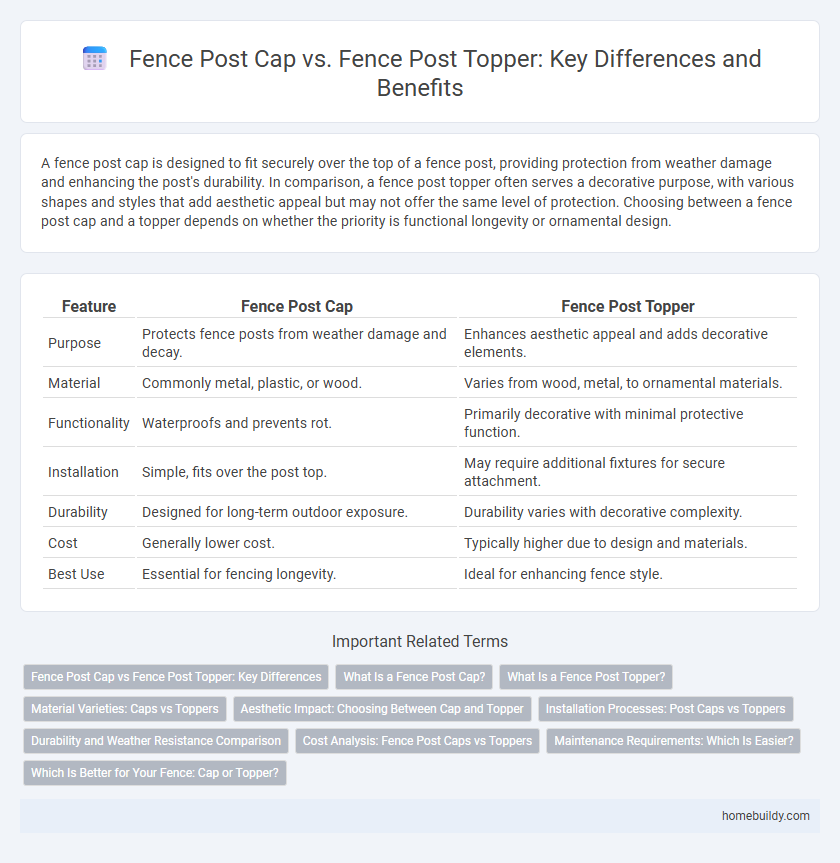A fence post cap is designed to fit securely over the top of a fence post, providing protection from weather damage and enhancing the post's durability. In comparison, a fence post topper often serves a decorative purpose, with various shapes and styles that add aesthetic appeal but may not offer the same level of protection. Choosing between a fence post cap and a topper depends on whether the priority is functional longevity or ornamental design.
Table of Comparison
| Feature | Fence Post Cap | Fence Post Topper |
|---|---|---|
| Purpose | Protects fence posts from weather damage and decay. | Enhances aesthetic appeal and adds decorative elements. |
| Material | Commonly metal, plastic, or wood. | Varies from wood, metal, to ornamental materials. |
| Functionality | Waterproofs and prevents rot. | Primarily decorative with minimal protective function. |
| Installation | Simple, fits over the post top. | May require additional fixtures for secure attachment. |
| Durability | Designed for long-term outdoor exposure. | Durability varies with decorative complexity. |
| Cost | Generally lower cost. | Typically higher due to design and materials. |
| Best Use | Essential for fencing longevity. | Ideal for enhancing fence style. |
Fence Post Cap vs Fence Post Topper: Key Differences
Fence post caps primarily serve as protective covers that prevent water damage and extend the lifespan of fence posts by sealing the top from moisture. Fence post toppers, on the other hand, are decorative elements designed to enhance the aesthetic appeal of the fence, often featuring unique designs or finials. While both can be functional and decorative, the key difference lies in the fence post cap's focus on protection and durability versus the fence post topper's emphasis on style and ornamentation.
What Is a Fence Post Cap?
A fence post cap is a protective and decorative covering installed atop a fence post to prevent water damage, wood rot, and insect infiltration, extending the post's lifespan. Unlike a fence post topper, which primarily serves an ornamental purpose, a post cap combines functionality with aesthetics, often featuring materials like metal, plastic, or wood. Choosing the right fence post cap enhances structural durability while adding a polished finish to the fencing design.
What Is a Fence Post Topper?
A fence post topper is a decorative or functional accessory designed to fit on the top of a fence post, serving to protect the post from weather damage and enhance its appearance. Unlike a standard fence post cap, which primarily provides protection, a fence post topper often includes ornamental features such as finials, lanterns, or solar lights to add aesthetic value. Both elements help extend the life of the fence post by preventing moisture penetration and decay.
Material Varieties: Caps vs Toppers
Fence post caps typically come in materials such as metal, plastic, and wood, offering robust protection against weather elements and enhancing durability. Fence post toppers are often crafted from decorative materials like resin, vinyl, or glass, emphasizing aesthetic appeal over structural reinforcement. These material differences highlight caps as functional barriers while toppers serve primarily as ornamental finishes.
Aesthetic Impact: Choosing Between Cap and Topper
Fence post caps provide a sleek, finished look that enhances the structural integrity and visual appeal of fence posts, often featuring materials like metal, wood, or vinyl that resist weathering. Fence post toppers, while similar, tend to offer more decorative and customizable options such as finials or lanterns, creating unique focal points that elevate the overall landscape design. Selecting between a cap and a topper depends on the desired balance of durability, style, and the aesthetic statement intended for the outdoor space.
Installation Processes: Post Caps vs Toppers
Fence post caps typically feature simple installation methods such as slipping over or being nailed onto the post, requiring minimal tools and time. Fence post toppers, often decorative, may involve more intricate attachment processes including screws or adhesives to secure detailed designs firmly. Understanding these installation differences helps choose the best option for both functionality and aesthetics in fencing projects.
Durability and Weather Resistance Comparison
Fence post caps typically offer superior durability due to their thicker materials and reinforced designs, providing enhanced protection against impact and weather damage. Fence post toppers are often decorative and lighter, which may reduce their ability to withstand harsh environmental conditions over time. Choosing a cap made from weather-resistant materials such as galvanized steel, vinyl, or solar-coated aluminum ensures longer-lasting protection compared to typical toppers.
Cost Analysis: Fence Post Caps vs Toppers
Fence post caps generally cost less than fence post toppers, making them a budget-friendly option for basic protection and aesthetic appeal. Toppers often include decorative elements and more complex designs, which increase their price but add a unique visual statement. Comparing materials like plastic, metal, or wood also impacts the overall investment, with metal toppers typically commanding higher costs than standard plastic caps.
Maintenance Requirements: Which Is Easier?
Fence post caps typically require less maintenance than fence post toppers due to their simpler design and fewer exposed components. Caps made from durable materials like vinyl or metal resist weathering and do not need frequent cleaning or repainting. In contrast, fence post toppers, often decorative and intricate, may demand regular upkeep to preserve both their aesthetic appeal and structural integrity.
Which Is Better for Your Fence: Cap or Topper?
Fence post caps provide a protective seal that prevents water damage and wood rot, enhancing the durability of your fence posts. Fence post toppers offer decorative appeal, coming in various designs that complement different fence styles while also providing basic protection. For long-term fence maintenance, caps are generally better for preventing structural damage, whereas toppers excel in aesthetic improvement.
fence post cap vs fence post topper Infographic

 homebuildy.com
homebuildy.com